新课标人教版英语选择性必修一Unit 4reading and thingking导学案(无答案)
- 格式:docx
- 大小:25.79 KB
- 文档页数:2
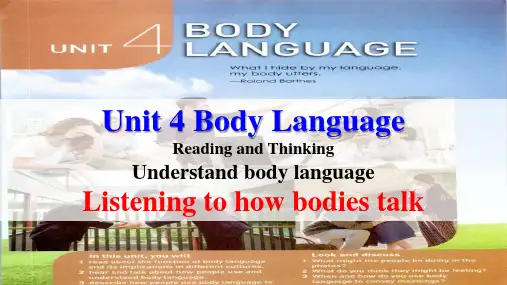
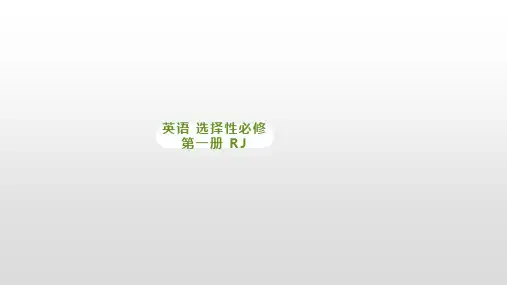
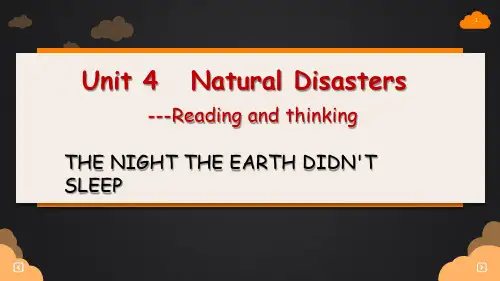
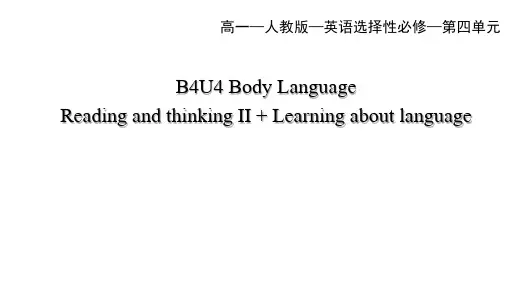
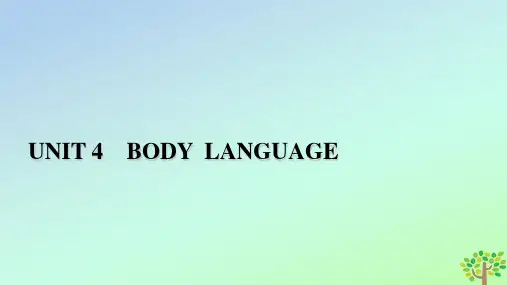
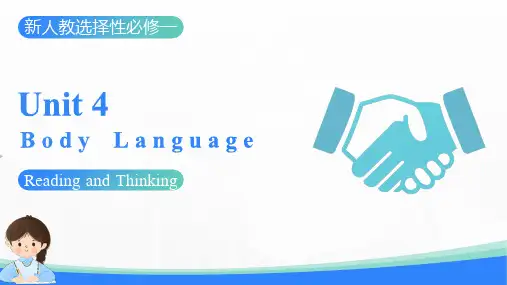

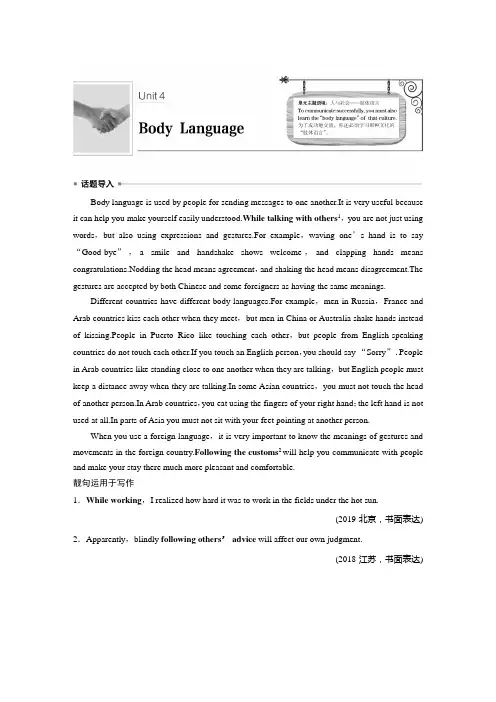
Body language is used by people for sending messages to one another.It is very useful because it can help you make yourself easily understood.While talking with others1,you are not just using words,but also using expressions and gestures.For example,waving one’s hand is to say “Good-bye”,a smile and handshake shows welcome,and clapping hands means congratulations.Nodding the head means agreement,and shaking the head means disagreement.The gestures are accepted by both Chinese and some foreigners as having the same meanings.Different countries have different body languages.For example,men in Russia,France and Arab countries kiss each other when they meet,but men in China or Australia shake hands instead of kissing.People in Puerto Rico like touching each other,but people from English-speaking countries do not touch each other.If you touch an English person,you should say “Sorry”.People in Arab countries like standing close to one another when they are talking,but English people must keep a distance away when they are talking.In some Asian countries,you must not touch the head of another person.In Arab countries,you eat using the fingers of your right hand;the left hand is not used at all.In parts of Asia you must not sit with your feet pointing at another person.When you use a foreign language,it is very important to know the meanings of gestures and movements in the foreign country.Following the customs2 will help you communicate with people and make your stay there much more pleasant and comfortable.靓句运用于写作1.While working,I realized how hard it was to work in the fields under the hot sun.(2019·北京,书面表达) 2.Apparently,blindly following others’ advice will affect our own judgment.(2018·江苏,书面表达)Period One Reading and Thinking—Comprehending匹配左边的单词与右边的汉语意思[第一组]1.interaction A.赞成;同意;批准;通过2.appropriate B.手势;姿势;姿态3.approve C.把……理解(解释)为;口译4.gesture D.交流;相互影响5.interpret E.合适的;恰当的答案 1.D 2.E 3.A 4.B 5.C[第二组]6.witness A.隔阂;障碍7.demonstrate B.使用;应用;雇用8.identical C.当场看到;目击;见证9.barrier D.表现;表达;说明;证明10.employ E.相同的答案 6.C7.D8.E9.A10.B[第三组]11.differ A.可靠的;可信赖的12.favour B.(使)弯曲;倾斜;偏向13.vary C.(根据情况)变化;改变14.reliable D.较喜欢;选择;有利于15.bend E.相异;不同于答案11.E12.D13.C14.A15.BStep 1Fast-reading1.What does the passage mainly talk about?A.Communication.B.Spoken language.C.Body language.D.Different cultures.答案 C2.Match each part with its main idea.Para.1A.The same gesture may have different meanings in different countries. Para.2 B.Smiling has many different uses.Paras.3-4 C.Body language varies from culture to culture.Para.5 D.Both words and body language are of importance in interactions with others. Para.6 E.Some gestures seem to have the same meaning everywhere.答案Para.1D Para.2C Paras.3-4A Para.5E Para.6 BStep 2Careful-readingChoose the best answer.1.In which countries are men and women not permitted to make eye contact?A.China and Japan.B.Middle Eastern countries.C.Brazil and Germany.D.Bulgaria and southern Albania.答案 B2.How does the passage develop(展开)?A.By giving examples.B.By giving data.C.By giving definition(定义).D.By analysing facts.答案 A3.What can we learn from the passage?A.In all countries,shaking the head means “No”.B.A smile can get a person into difficult situations.C.In Russia,people favour bowing from the waist when they meet someone else.D.If a person moves his hand in circles over his stomach after a meal,that means he is full. 答案 D4.Which proverb can best describe the main idea of the passage?A.Never too old to learn.B.When in Rome,do as the Romans do.C.Four eyes see more than two.D.Every country has its own customs.答案 B5.Which of the following can NOT be conveyed(传达) through the gesture of “smiling”?A.Apology. B.Greeting.C.Anger. D.Asking for help.答案 CStep 3Post-readingAfter reading the passage,please fill in the following blanks.Gestures can 1.be used(use) to express people’s thoughts and opinions in their interactions 2.with other people,but in different countries the same gesture may have different meanings.For example,in some countries,looking into the eyes of the person you are talking to 3.is(be) a way to display interest,but in many Middle Eastern countries men and women should avoid 4.making(make) eye contact.In most countries,5.shaking(shake) one’s head means “no”,and nodding means “yes”.By parison(compare),in Bulgaria and southern Albania,the gestures have the opposite meaning.In countries 7.like France and Russia,people may kiss their friends on 8.the cheek when they meet.Elsewhere,people favour shaking hands,bowing from the waist,or nodding the head when they meet someone else.All in all,body language 9.varies(vary) from culture to culture,but it is safe 10.to follow(follow) the golden rule—When in Rome,do as the Romans do.Step 4Sentence-learning1.Words are important,but the way people stand,hold their arms,and move their hands can also give us information about their feelings.[句式分析]本句是一个由but连接的并列句。
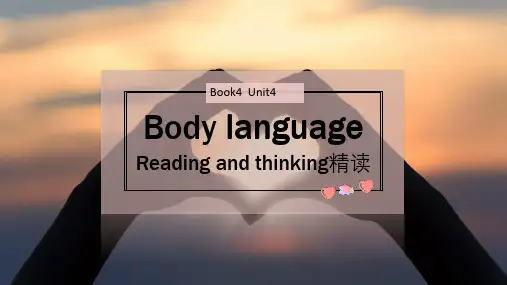
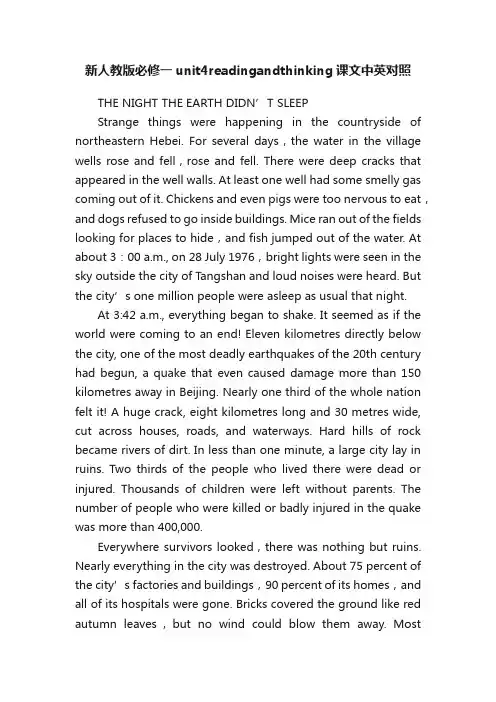
新人教版必修一unit4readingandthinking课文中英对照THE NIGHT THE EARTH DIDN’T SLEEPStrange things were happening in the countryside of northeastern Hebei. For several days,the water in the village wells rose and fell,rose and fell. There were deep cracks that appeared in the well walls. At least one well had some smelly gas coming out of it. Chickens and even pigs were too nervous to eat,and dogs refused to go inside buildings. Mice ran out of the fields looking for places to hide,and fish jumped out of the water. At about 3:00 a.m., on 28 July 1976,bright lights were seen in the sky outside the city of Tangshan and loud noises were heard. But the city’s one million people were asleep as usual that n ight.At 3:42 a.m., everything began to shake. It seemed as if the world were coming to an end! Eleven kilometres directly below the city, one of the most deadly earthquakes of the 20th century had begun, a quake that even caused damage more than 150 kilometres away in Beijing. Nearly one third of the whole nation felt it! A huge crack, eight kilometres long and 30 metres wide, cut across houses, roads, and waterways. Hard hills of rock became rivers of dirt. In less than one minute, a large city lay in ruins. Two thirds of the people who lived there were dead or injured. Thousands of children were left without parents. The number of people who were killed or badly injured in the quake was more than 400,000.Everywhere survivors looked,there was nothing but ruins. Nearly everything in the city was destroyed. About 75 percent of the city’s factories and buildings,90 percent of its homes,and all of its hospitals were gone. Bricks covered the ground like red autumn leaves,but no wind could blow them away. Mostbridges had fallen or were not safe to cross. The railway tracks were now useless pieces of metal. Tens of thousands of cows,hundreds of thousands of pigs,and millions of chickens were dead. Sand now filled the wells instead of water. People were in shock—and then,later that afternoon,another big quake shook Tangshan again. Even more buildings fell down. Water,food,and electricity were hard to get. People began to wonder how long the disaster would last.But hope was not lost. Soon after the quakes,the army sent 150,000 soldiers to Tangshan to dig out those who were trapped and to bury the dead. More than 10,000 doctors and nurses came to provide medical care. Workers built shelters for survivors whose homes had been destroyed. Hundreds of thousands of people were helped. Water and food were brought into the city by train,truck,and plane. Slowly,the city began to breathe again.Tangshan started to revive itself and get back up on its feet. With strong support from the government and the tireless efforts of the city’s people,a new Tangshan was built upon the earthquake ruins. The new city has become a home to more than seven million people,with greatimprovements in transportation,industry,and environment. Tangshan city has proved to China and the rest of the world that in times of disaster,people must unify and show the wisdom to stay positive and rebuild for a brighter future.地球的一个不眠之夜河北省东北部的农村地区怪事连连:一连几天,村子里的井水升升降降,起起伏伏,井壁上出现了深深的裂缝。
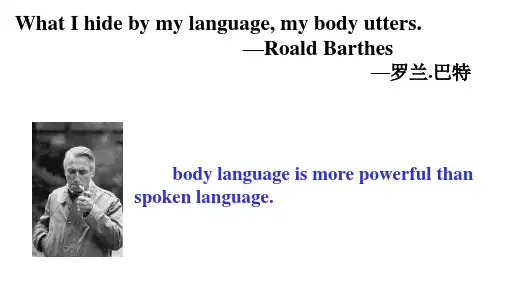
Unit 4 Body Language
Listening to How Bodies Talk
【核心素养】
1. reading about the function of body language and its implications in different cultures.
2. hear and talk about how people use and understand body language.
3. can understand the difficult and complex sentences.
【情景导入】
1.What might the people be doing in the photos?
2.When and how do you use body language to convey meanings?
【阅读深思】
Read the text Listening to How Bodies Talk on page38 and answers these questions:
1.Can you think of an example of body language that is appropriate in China but might be
misunderstood in another culture?
2.What advice on body language can you give a foreign friend on his/ her first trip to China?【自主反馈】
【自主探究】
探究一:Fast reading: find out the main idea of each paragraph.
Para.1 A body language varies in different cultures
Para.2-4 Some body language shows different meanings in different situations Para.5 Body language is another way to communicate
探究二:Careful reading:
1.What is the main idea of the text?
A. The culture differences of body language
B. The differences between body language and spoken language
C. The characteristics of body language
D. How body language is used
2.The gesture for “Ok” has the meaning _________ in France.
A. money
B. impoliteness
C. zero
D. permission
3.Which of the body languages has many different users?
A. Closing one’s eyes
B. Placing one’s hands together
C. Moving one’s hand in circles over the stomach
D. Smiling
【成果展示】
to present the answers in groups.
【点评精讲】
1.Core words and expressions.
2.Difficult and complex sentences.
【随堂检测】
Try to fill the blanks with correct words and then retell the passage.
We use both words and body language _________ (express) our thoughts and opinions in our _________ (interact)with other people. Just like spoken language, body language _________(vary)from culture to culture. The crucial thing is using body language in a way_________ is appropriate to the culture you are in. For example, _________(make)eye contact is not appropriate to all cultures. Some gestures like the _________ for "OK” have different meanings in different cultures. Even the gestures we use for "yes and no” differ around the world. There are also differences _________ how we touch each other, how close we stand _________ someone we are talking to, and how we act _________ we meet or part. Such gestures_________ the ones for "sleep" and " I am full" seem to have the same meaning everywhere. Some body language has many different uses. One example is smiling.
【巩固应用】
to finish the exercise about this text.。